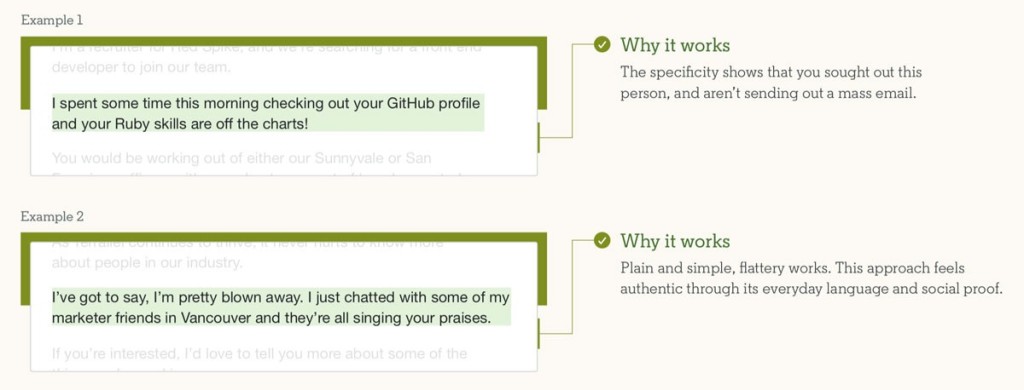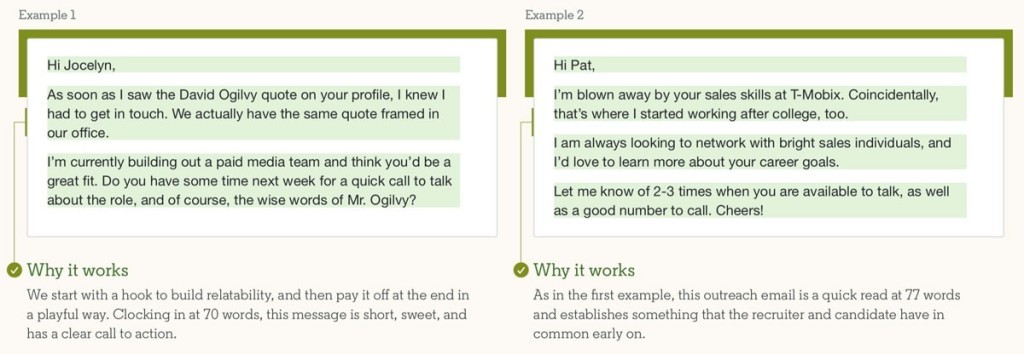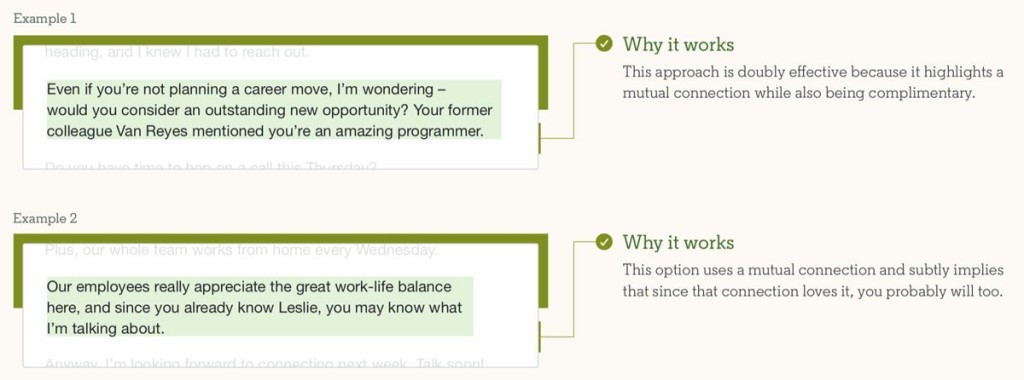
Every recruiter has a “one that got away” story — that perfect candidate who just seemed to slip through their fingers. But when that ideal candidate doesn’t even respond to your first outreach message, it can feel especially gutting.
In a competitive talent market, it helps if your emails and InMails (private messages on LinkedIn) stand out in a candidate’s busy inbox. If you don’t make a compelling first impression, your messages probably won’t get opened, let alone answered.
To help find your next great hire and improve your response rate, here are five top tips from veteran recruiters that can improve your outreach messaging efforts.
1. Open strong: A short, catchy subject line leaves candidates curious to see what you have to say
Your subject line is your first opportunity to grab a candidate’s attention — and it can make or break your chances of getting a response.
If a candidate is happy at their current company, they’re not exactly going to leap into action when they read a subject line like “Trying to fill X position” or “Career opportunity.” And in a candidate-driven market where they may be receiving dozens of generic-looking messages, the chances of them opening your generic-looking message are even slimmer.
It doesn’t matter how good the opportunity is if the candidate never gets as far as reading about it. This makes your subject line the most important part of your message to get right.
“The best advice I ever received was to keep the subject line short and punchy,” says Maire O’Connor, an executive talent researcher at Hubspot. “I like to put on my candidate hat and ask myself what would make me want to open a message.”
Keep your subject lines concise. A little intrigue encourages the candidate to open the message to see more, so you don’t want to give too much away up front. And whenever possible, try to build a personal connection — like calling out a shared interest or past employer.

A subject line like “Hello from a fellow bulldog owner” immediately signals to the candidate that you’ve taken the time to read their profile beyond their job title. It also makes cold outreach feel a lot warmer, motivating the candidate to at least see what else you have to say.
2. Make a connection: A few personalized touches can increase response rates by 20%
Even if you have a great subject line, a candidate is unlikely to respond — or even read as far as the final line — if your message was clearly copied and pasted.
“You never want someone to think they’re getting spammed,” cautions Maria Mencias, a senior recruiter at identity and access management company Okta.
You can still use a template. But the last thing you want is for your message to feel like a template. Luckily, it only takes a few tiny tweaks to dispel that feeling.
Call out a specific article or blog post the candidate has written and shared on social media. Reference something from their background, like a company they once worked for or an initiative they pioneered. It doesn’t have to be something groundbreaking — even a reference to an unusual hobby they list on their profile will do the trick.

Again, this strategy works because it shows you’ve done your research. People like to feel noticed, and pinpointing something specific shows you’re really paying attention.
“A few personalized touches,” Maria says, “really help make your message feel tailored to them.”
LinkedIn data shows that response rates increase by 20% when talent professionals personalize their messages, so it’s definitely worth taking the extra time. For in-demand candidates in particular, it might be the thing that sets your job opportunity apart from a dozen others clamoring for their attention.
3. Recognize the candidate’s skills: A little sincere flattery goes a long way
While you’re considering ways to personalize your messages, don’t be afraid to add a little flattery into the mix. When people feel that their skills and efforts are being recognized, they’re more motivated to help others — which, in this case, means responding to your message.
So, let the candidate know what makes them special. After all, you went to all the trouble of sourcing them, so something must have caught your eye. Be sure to give specifics to show that you’re sincere. Don’t just say “your background is impressive” — mention what exactly is impressive about it and why.

Better yet, draw an explicit line between the candidate’s achievements and the reason you’re interested in them — like spotlighting a rare skill that your company needs or expressing that they were referred to you by people in the know.
“Make sure that whatever skill or accomplishment you recognize aligns with why you’re reaching out,” advises Cam Pezet, senior campus recruiter at LinkedIn. “Otherwise, it may cause confusion and drive a candidate to not respond.”
In fact, LinkedIn research found that over half of all candidates expect recruiters’ messages to contain specifics about why their particular accomplishments make them a good fit for the organization. So if you don’t take this step, don’t hold your breath for an enthusiastic response.
4. Be direct and succinct: Include clear next steps and remember that messages between 200 and 400 characters prompt higher response rates
Less is more, as the saying goes. And when it comes to cold outreach, that’s definitely true.
LinkedIn data reveals that InMails between 200 and 400 characters tend to be met with higher response rates. Messages that are over 400 characters, on the other hand, get fewer responses, so keep it short and sweet.
The data also shows that candidates are more likely to respond to you if you hold some of the details back. They want to learn about the opportunity, but don’t give them everything just yet. A small taste will leave them curious to find out more, even if they’re not actively looking for a new job.
While you’re considering what to keep and what to cut, there’s one detail you mustn’t forget to include.
“Keep your message short, and be sure to include clear next steps or a call to action,” says Shiram Gharpure, senior engineering and technical recruiter at financial services company Robinhood.

Adding a simple next step or call to action tosses the ball into the candidate’s court, encouraging them to pick it up and toss it back to you.
Be polite and respect that they’ve likely got other things going on, especially if they’re currently employed elsewhere and potentially have childcare or eldercare responsibilities at home. Rather than trying to set a date and time right off the bat, prompt them to provide a few time slots that work with their schedule. If you push, you’ll only succeed in pushing them away.
5. Use your network: Try to highlight connections you have in common
If you reference a former common employer in your first message to a candidate, your chances of getting a response leap by 27%. And something similar happens when you mention a common connection.
“Make sure to use your network first by checking if you have a connection in common,” says Calvin Liu-Navarro, senior technical recruiter at Robinhood.
If you regularly recruit candidates in the same industry and region, there’s a good chance that you do share some common connections. First things first, check if anyone who works at your company also happens to be connected with the candidate. Mentioning that employee’s name is a quick way to let the candidate know that your company is worth checking out — because if their friend enjoys working there, they probably will too.
If that strategy doesn’t work out, see if you share any connections with the people who have endorsed the candidate’s skills or given them a recommendation. Calling out this kind of connection — like mentioning that the candidate’s former coworker recommended them for their amazing coding skills — can also serve as a sincere form of flattery, making it extra effective.

If you don’t share any connections, it’s not the end of the world. There are other ways to forge connections.
“Another way I get responses is by sharing videos I make with hiring managers,” Calvin says. “People love them.”
Make a lasting first impression
You only get one chance at a first impression. Make it a good one by following these simple best practices and strategies.
.................
Authored by Samantha McLaren
Lead Copywriter, Global Impact @ LinkedIn
February 3, 2022





